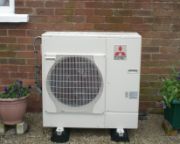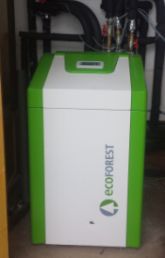Heat pumps come in many forms. The most common types are summarised as follows
Reversible air-conditioners / heat pumps – air-to-air
These are very widespread, especially in warmer climates. They can provide heating, but may not be considered be the best appliance for ‘proper’ house heating. (But read my blog! )
Air Source heat pumps (ASHPs) air-to-water
 These are now the most common method of heating. They extract heat from outside air and produce hot water for either underfloor heating or radiator circuits. They can also heat a cylinder for domestic hot water (DHW).
These are now the most common method of heating. They extract heat from outside air and produce hot water for either underfloor heating or radiator circuits. They can also heat a cylinder for domestic hot water (DHW).
Ground source heat pumps (GSHPs) glycol-to-water
 These extract heat from the ground using either boreholes or horizontal trenches. They produce heated water in the same way as ASHPs. GSHPs have occasionally referred to as Geothermal but this term is debatably incorrect.
These extract heat from the ground using either boreholes or horizontal trenches. They produce heated water in the same way as ASHPs. GSHPs have occasionally referred to as Geothermal but this term is debatably incorrect.
Unlike the ASHP, this unit is usually installed inside the house. Normally is a utility room.
Water source heat pumps (WSHPs) water-to-water
Water source systems extract heat from rivers, lakes or springs.
Spring source can give very good results, but are not very common.
Air source domestic hot water heaters (DHW)
These take the form of a hot water cylinder with a small air source heat pump on top. They may take the heat from oustide air, but some smaller units take heat from ventilation air extracted from the building
Heat recovery
There are various situations where there is a ‘waste’ heat that is a little too cool for apparent use. Direct (passive/free) heat-exchange would be the first thing to consider, but heat pumps can ‘elevate’ the heat to more useful temperatures and can have many commercial uses. ‘Waste’ heat from refrigeration is a form of heat recovery.
For households, heat recovery from ventilation air is an option. This often simply heats the incoming fresh air.
Heat distribution in the building (the heat emitter system)
Air-to-air systems can simply blow (recirculate) warmed air into a room. Larger systems may be ducted to various rooms. However, in Europe, the most common method of emitting heat is via warmed water that circulates in pipes to panel radiators or underfloor heating. ‘Emitters’ or ‘Heat emitters’ is a common term for either radiators or underfloor heating
Cooling
Air-conditioning is the commonly-used term for cooling buildings.
Even in temperate climates, the inside of a building can become uncomfortably warm. This is often due to direct sunlight coming through windows and also heat generated from people and activities within the building. Rather than immediately considering air-conditioning, it makes a great deal of sense to improve matters by sun-shading, good ventilation and minimising heat generated within the building. Indeed, in the UK many consider air-conditioning unnecessary.
Modern buildings should be designed to help mitigate overheating, but if the climate is simply too hot, there may be no option other than to use some sort of forced cooling. Blown cool air is the most common method; however, reducing the temperature of a stone floor can be an effecting way of increasing comfort.
Passive cooling (*)
Water from a ground source system can be pumped directly around some underfloor heating system. This is sometimes called free-cooling, and is very cheap to run. Again, it must be designed well. It usually works best with boreholes or large deep horizontal collectors.
Note* the term 'passive' is used here when no heat pump is involved. If a heat pump (in reverse) is producing cold water, it is termed 'active cooling'